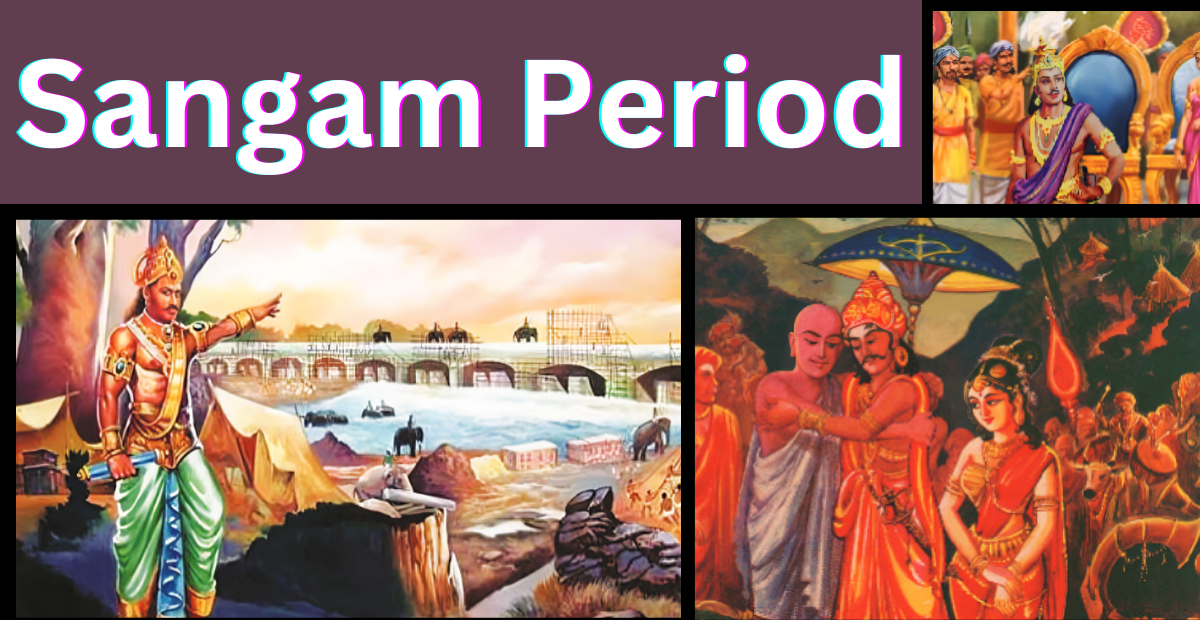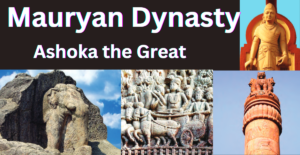Sangam Age
Introduction:
Sangam Age ,It was bounded by the coast from Venkatam Tirupati in the north to Kanyakumari in the south.The Iron was similar to.It has a megalithic culture.The period from the last three centuries before the Common Year to the first three centuries starting after the Common Year is known as the Sangam Age.It is named after the academies that flourished under the royal patronage of the Pandya kingdoms of Madurai.Much of the information about the Sangam Age is derived from Sangam literature.These literary works are one of the earliest examples of Dravidian literature
Sangam Age Evidences:
Inscriptions:
- Hithigumpha inscription of King Kharavela, Pugalur inscription and Peranmai inscription of Ashok II and XIII. Inscriptions within Mankulam, Azhagar malai and Keelavaluvu (places near Madurai).
Copperplates:
- Velvikudi and Chinnamanur copper plates.
Coins:
- Coins issued by Chera, Chola, Pandya kingdoms and chieftains of Sangam Age and Roman coins.
Monuments: Burials, Middle Stones
Excavation Locations:
- Adichanallur, Arikkamedu, Kodumanal, Puhar, Korkai, Azhagankulam, Uraiyur.
Literary Evidence:
- Tholkappiyam, Ettuthogai, Pattupattu, Pathinenkilkanakku, Pattinappalai and Madurai Kanchi. Manimekalai and Silappathikaram.
Foreigner Notes:
- The Periplus of the Erythraean Sea, the Natural History of Pliny, the Geography of Ptolemy, the Indica of Megasthenes, the Rajavali, the Mahavamsa and the Dipa Dynasty.
Sangam Age –Political Culture:
Moovendhars:
The Sangam literature of the 1st century and later is known about the Moovenda kings.The Chera, Chola and Pandya kings known as Moovendhars controlled most of the agricultural lands, trade routes and cities.
Cheras:
The Cheras ruled over Central and North Travancore, Cochin, South Malabar and Kongu region of Tamil Nadu.They ruled with Vanji as their capital. Today’s Karur.Musiri and Thondi ports were under their control.They ruled with ‘bow and arrow‘ as their symbol.Some scholars say that a place called Thiruvanchisaikalam in Kerala was called Vanchi.Many scholars have said that there were two branches of the Chera royal family and the ‘Poraiyar‘ branch ruled in Karur city of Tamil Nadu.Pathitrupattu gives information about the Chera kings.
The main Chera kings were:
- Uthayan Cheralathan
- Himayavaramban Neduncheralathan
- Cheran Senguttuvan
- Cheral Irumporai
The Pugalur inscription mentions three generations of Chera kings.Senguttuvan was called ‘Senchera‘ or ‘Nallacheran‘.The Silappathikaram states that the Chera king Senguttuvan invaded northern India and also invaded the Himalayan regions.He worshipped the goddess ‘Pattinith‘. He supported both orthodox and non-Vedic Their coin bore bow and arrow symbols without anySenguttavan ruled for 56 years.Pathitrupattu talks about the eight Chera kings, the regions they ruled and their achievements.
Chola:
The Chola kingdom of the Sangam Age extended from Trichy district to the Venkata hills.The Cauvery delta was the heart of the Chola kingdom and was later known as Coromandel.
Important Chola Kings:
- Ilanjotchenni
- Karikal Valavan
- Kochenganan
- Killivalavan
- Perunarkilli
They ruled with ‘Puli‘ as their symbol.They established their capital at Uraiyur.Puhar or Kaveri Poopattinam was an important port and the residence of royal families.I referred to the bustling commercial activities in Kaveripoompattinam during the reign of Karikalan. Kadiyalur Uruthirakannanar has explained Pattinappalai in detail.Ilanjotchenniyan’s son Karikalan is known as the chief of the Chola kings.Pattinappalai describes the administrative methods of Karikalan.Karikala Chola defeated the Cholas, the Pandyas and the 11 Velar chieftains who helped him in the battle of Venni. This battle took place in Venni, a small village in the Thanjavur region.Another notable battle he waged was Paranthalai.They converted forests into land for sale.He built Kallanai across the river Kaveri for the development of agriculture. The Chola port of Puhar attracted merchants from many parts of the Indian Ocean.
Pandyas:
They ruled the present South Tamil Nadu.They ruled with Madurai as their capital.They ruled with fish as their symbol.Their coin has a picture of an elephant on one side and a tiger on the other.Korkai port was their main face. It is known for pearl bathing and collecting conch shells.In the Periplus notes, Korkai is referred to as ‘Kolkoi’.Only the names of the Pandya kings are mentioned in the Sangam songs, and there are no details about when they assumed the throne and what their year period was.
Important Pandya Kings:
- Nedeon
- Nanmaran
- Dorsal aorta
- Nedunchezhiyan
The Mankulam Tamil-Brahmi inscription mentions the Pandya king Nedunchezhiyan of the 2nd century.Nedunchezhiyan defeated the combined armies of Cheras, Cholas and 5 Velir chieftains in the battle of Talailaganattu.Through the war, they brought the Nelkinda port near Kottayam under their control.The Pandyas supported the Tamil Sangams and compiled Sangam texts.
The titles assumed by the Moovendhars were:
Cheras: Aadhavan, Kuttuvan, Vanavan, Irumporai
Cholas: Chenni, Sembian, Gilli, Valavan.
Pandyas: Maran, Vazhuthi, Chezhiyan, Thennar.
Sangam Age-Small Land Kings:
- Apart from these three crowned kings, there were many independent Kuru kings.
- The name Ay: The name Ay is derived from the ancient Tamil word ‘Ayar ‘. Andhra, Titian and Nannan were important kings.
- Vellars: Vellalas or a feudal class who ruled in ancient Tamilakam. Pari, Kari, Ori, Adhiyaman and Nalli were famous philanthropists.
Sangam Age Administrative System:
There was a traditional monarchy in the Sangam Age.The king was called by the word ‘Go’. They were also known by other names as Vendan, King of Koan, Kotravan and Lord.According to the hereditary tradition, the eldest son succeeded to the throne.The crown was awarded to the king by a ceremony known as the coronation or coronation.The crown prince is called the Duke. He is also known as Ilaiyar, Ilango, Ilancheliyan and Ilancheral.The king convened the court every day.Each king had a standing army and a standard.
The revenue of the state was derived from taxes. Land revenue is the main source of revenue. The status line was called ‘Irai‘.Customs duties, tributes and fines were also collected.Warriors and kings wore heroic necklaces.It bears the wearer’s name and his or her achievements.They came to know about what was happening at home and abroad through spies.The court of kings was called the ‘court‘.The king used to sit on a seat called ‘throne‘.In the court, the king was surrounded by officials, special guests and poets.
There were five duties of the king:
- Promoting learning
- Conducting rituals
- Awarding prizes
- Protecting people
- Punishing the offenders
- Ambassadors were employed by the kings.
- Many officials helped the Among them there were two aid groups, Aimperunkuzhu and Emperayam.
Sangam Age-Administration:
Mandalam Naduà àKooramà Town The villages were called Perur (big village), Chittur (small village) and Muthur (ancient village).
Major cities:
- Puhar, Uraiyur, Korkai, Madurai, Musiri, Vanchi Kanchi.
Sangam Age-Military:
The king’s army consisted of four divisions. They are infantry, cavalry, elephants and chariots.The commander is called ‘Thanai Thalaivan‘.Tail, shield, tomaram (like a missile), spear, bow and arrow were the main weapons used.‘Barracks‘ is an arsenal.The fort walls were protected by deep trenches.The war drum was considered a god.
Sangam Age –Law and Justice:
The King is the final court of appeal.The courts were called ‘avai‘ in the towns and ‘mandrams‘ in the villages.Severe punishments were meted The death penalty was given for theft cases.Beheading, mutilation, torture, imprisonment and imposition of fines were the punishments for crimes.
Tinai based Sangam Age Society:
The Sangam literature is of great help to us to understand the social formation of that period.The lands were divided into five tinais.Lands were classified according to the type of soil.Marudham land is called ‘Menpulam‘ (wet work).Except for weaving, the rest is called ‘Vanpulam‘ (Punsei).Grains described pulses.
| Department | Land form | Main Deity | occupation | people |
| Kurinji | Hilly & hilly area | Murugan (God of War and Hunting) | Hunting & Honey Gathering | Kuravar, Kurathiya |
| Mullai | Forest and Forest | Mayon (Vishnu) | Livestock Grazing and Dairy Production | Bharathava, Nulathiar |
| Marutham | Agricultural Plains | Indra (God of Rain & Thunder) | Agriculture & Weaving | Vellalar |
| Neidel | Coastal Areas | Varuna (God of water and sea) | Fisheries and Salt Production | Paraiyar |
| Palai | Dry & Desert | Kotravai (Goddess of War and Victory) | Adventures & Raiding | Maravar |
Status of women:
There are no restrictions on women in social life.There were more educated and intelligent women.There were 40 women poets who lived and gave rare books. There were women poets like Avvaiyar, Velli Veediyar, Kakkaipadiniyar, Adimanthiar and Ponmudayar.Marriage was based on women’s own choice. However, pregnancy was considered the best discipline for women.The property of the parents was equally shared by the sons and daughters.
Religious beliefs and social divisions:
The people worshipped the god Seyon or Muruga as their primary deity.Other gods worshipped Shiva, Mayon (Vishnu), Indra, Varuna and Kotravai.Nadukal worship was in vogue.The caste system had not developed.
Clothing and accessories:
The more affluent people wore clothes made of muslin, silk and fine cotton leaf fabrics.Sangam literature mentions cloths (Kalinga) which are softer than snake skin.Men and women wore different kinds of ornaments.It was made of gold, silver, pearls, gems, stones , conch shells and beads.
Sangam Age-Arts:
There are many references to various musical instruments such as drums, flutes, yazh, etc.Karikalan was proud of his musical colours.The poets were called ‘Panar‘ and ‘Viraliyar‘.There was a dance performance.Koothu was an important cultural feature.They developed the concept of Muthamizh ( literature, music and drama).
Industries:
- The most important occupations of the people were agriculture, cattle rearing, fishing and hunting.
- There were also artisans like carpenters, blacksmiths, goldsmiths and potters.
- Weaving and farming were made part-time and full-time occupations by all people.
Sangam Age-Economy:
Agriculture was the most important occupation. Paddy was cultivated in large quantities.Other crops are ragi, sugarcane, cotton, pepper, ginger, turmeric , cinnamon and a variety of fruits.Malabar exported black pepper to Egypt.The handicrafts of the Sangam Age were popular. Includes weaving, metalworking and carpentry, making jewelry from beads, stones, and ivory. Cotton and silk textiles, spinning and weaving reached a high Merchants moved goods from one place to another with the help of carts and animals.The method of conversion was used.Roman trade gained prominence after the rise of the Roman Empire.As large ships carrying valuable goods reached the port, the city of Puhar became a foreign trading centre.
Light towers called ‘Kadankarai Ilangusdar‘ were built in important ports.Thondi, Musiri, Korkai and Arikkamedu are the other commercial ports.Madurai had morning markets called Nalangadi and evening markets called Allangadi in Madurai.A large number of gold and silver coins minted by Roman emperors like Augustus, Tiberius and Nero were discovered all over Tamil Nadu.Cotton textiles, spices like pepper, ginger, cardamom, cinnamon and turmeric, ivory articles , pearls and precious stones were exported during the Sangam Age.The most important imports were topaz, horses, and tin and




Pingback: Chola dynasty